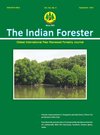Mineral Composition of Fruits of Seabuckthorn (Hippophae L.) Growing in Lahaul Valley of Himachal Pradesh
DOI:
https://doi.org/10.36808/if/2016/v142i9/102553Keywords:
Mineral Composition, Seabuckthorn Fruit Pulp, Lahaul Valley, Himachal Pradesh.Abstract
Mineral composition (Zn, Cu, Fe, Ca, Mg, Na and K) of seabuckthorn fruit pulp and seed components were studied in 8 populations of seabuckthorn (H. rhamnoides ssp. turkestanica and H. salicifolia) growing in Lahaul valley (2600-3200 m asl), a dry temperate Himalayan region of Himachal Pradesh. In fruit pulp of H. rhamnoides, Zn varied from 8.7 to 12.5 ppm; Cu, 3.1-4.7 ppm; Fe, 427-800 ppm; Ca, 2310-3375 ppm; Mg, 500-585 ppm; Na, 55-137 ppm and K, 8575-10025 ppm and in seed, Zn varied from 20.7 to 27.8 ppm; Cu, 4.1-8.4 ppm; Fe, 18.1-74.7 ppm; Ca, 480-1380 ppm; Mg, 1080-1725 ppm; Na, 60- 133 ppm and K, 6225-9350 ppm. The values of Zn, Cu, and Mg were higher in the seeds as compared to pulp, where as other minerals (Fe, Ca and K) were higher in pulp, with the exception of Na, which was almost similar in both parts. The values for H. salicifoliawere in general in the range of H. rhamnoides populations.References
Eliseev I.P. (1977). Content of trace elements in seeds of Hippophae rhamnoides. Tr.Sor-s-kh-in-ta, 105: 23-25.
Glazunova E.M., Gachechiladze N.D., Mukhtarova E.S., Guryanov A.F., Pachajanov D.N. and Vainberg V.I. (1989). Microelements of Seabuckthorn. In: Proceedings of International Symposium on Seabuckthorn, Xian, China, p.128,
JADA (1990). Journal American Dietetic Association July. 96p.
Kallio H., Baoru Y., Tahvonen R. and Hakala M. (1999). Composition of seabuckthorn berries of various origins. In: Proceedings of International Workshop on seabuckthorn, (IWS 99), p. 13-19, China.
Mcdowell L.R. (1992) (Ed.). Minerals in Animal and Human Nutrition. Academic Press.
Rongsen L. (1992). Seabuckthorn-A multipurpose plant species for fragile mountains. ICIMOD Occasional paper, No. 20, Kathmandu, Nepal, 62 p.
Singh V. (1994). A report on arboreal seabuckthorn (Hippophae salicifolia) from dry temperate Himalayas. J. Tree Sciences, 3: 67-68.
Singh V. (1995). Rooting rates of hardwood cuttings of seabuckthorn (H. rhamnoides). J. Tree Sciences, 14: 87-88.
Singh V. (2003). Geographical adaptation and distribution of seabuckthorn (Hippophae L.) resources. In: A Multipurpose Wonder PlantBotany. Vol. I. Botany, Harvesting and Processing Technologies, (V. Singh editor in chief), p.21-34, Indus Publishing Company, 5 FSTagore Garden, New Delhi, 518p.
Singh V. and Dogra K.K. (1996). Characteristics, utilization, regeneration, biomass yield and nutritional value of seabuckthorn. Indian Forester, 122(6): 486-491.
Singh V. and Gupta R. (2014). Micropropagation of seabuckthorn (Hippophae spp L.). Inter. J. Medicinal and Aromatic Plants, 6(2): 131-139.
Singh V., Singh B. and Awasthi C.P. (1995). Distribution, taxonomy and nutritional value of seabuckthorn (Hippophae L.) in dry temperate Himalayas. In: Proc. Int. Workshop Seabuckthorn, Beijing, China, p. 52-59.
Singh V. and Singh R.K. (2004). Morphobiochemical variations in seabuckthorn (Hippophae L.) populations growing in Lahaul valley, dry temperate Himalayas. Indian Forester, 130(6): 663-672.
Styker W.S., Stampfer M.J., Stein E.A., Kaplan L., Louis T.A., Sober A. and Willet W.C. (1990). Diet, plasma levels of beta-carotene and alphatocopherol, and risk of malignant melanoma. American J. Epidemiology, 131: 612.
Tigong C. (1988). Studies of the biochemical composition of Hippophae and its quality assessment in Gansu province. Hippophae, 1: 19-26.
Woolliams C., Suttle N.F., Woolliams J.A., Jones D.G. and Wiener G. (1986). Studies on lambs genetically selected for low and high copper status. I. Differences in mortality. Animal Production, 43: 293
Downloads
Downloads
Published
How to Cite
Issue
Section
License
Unless otherwise stated, copyright or similar rights in all materials presented on the site, including graphical images, are owned by Indian Forester.





